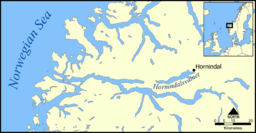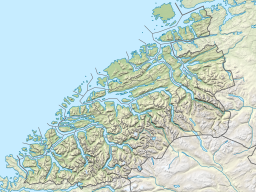Hornindalsvatnet
| Hornindalsvatnet | |
|---|---|
 Lake view from Grodås | |
 Location of Lake Hornindalsvatnet | |
| Location | Møre og Romsdal and Vestland |
| Coordinates | 61°56′N 6°19′E / 61.933°N 6.317°E |
| Type | glacial fjord lake |
| Primary inflows | Horndøla, Melheimselva (Heggjadalselva), Sindreelva and Vikaelva |
| Primary outflows | Eidselva |
| Catchment area | 381.68 km2 (147.37 sq mi) |
| Basin countries | Norway |
| Max. length | 24 km (15 mi) |
| Max. width | 3.3 km (2.1 mi) |
| Surface area | 50.76 km2 (19.60 sq mi) |
| Average depth | 237.6 m (780 ft) |
| Max. depth | 514 m (1,686 ft) |
| Water volume | 12.06 km3 (2.89 cu mi) |
| Shore length1 | 65.64 km (40.79 mi) |
| Surface elevation | 53 m (174 ft) |
| Islands | Bjørnaholmen |
| References | Hornindalsvatnet Data[1] |
| 1 Shore length is not a well-defined measure. | |

Hornindalsvatnet is Norway's and Europe's deepest lake,[2] and the world's thirteenth deepest lake, officially measured to a depth of 514 m (1,686 ft). Its surface is 53 m (174 ft) above sea level, which means that its bottom is 461 m (1,512 ft) below sea level.
The village of Grodås lies at the eastern end of the lake in Volda Municipality in Møre og Romsdal county and the village of Mogrenda is located on the western end of the lake in Stad Municipality in Vestland county. The European route E39 highway runs near the lake. The village of Heggjabygda and Heggjabygda Church lie on the northern shore of the lake.
Its volume is estimated at 12 km3 (2.9 cu mi), its area is 51 km2 (20 sq mi) and ranks 19th in area among Norway's lakes. The main outflow is the river Eidselva, which flows into the Eidsfjorden, an arm off the main Nordfjorden.
The deepest point of the lake was explored using a ROV in 2006.[3] A small white fish was discovered on the lake bottom – probably a new species of Arctic charr (Salvelinus alpinus). It was previously also located in Lake Tinn, Norway's third deepest lake.[4]
The lake is also the site of the Hornindalsvatnet Marathon, held annually in July.[5]

See also
[edit]References
[edit]- ^ Seppälä, Matti (2005). The Physical Geography of Fennoscandia. Oxford University Press. p. 145. ISBN 978-0-19-924590-1.
- ^ Henriksen, Petter (1998). Aschehoug og Gyldendals store norske leksikon. 16: Nøkkelbind. Kunnskapsforlaget. Page 97. ISBN 8257310808.
- ^ Søreide, Fredrik. "Secrets of Europe's deepest lakes. Discoveries from Norway". Sea Technology. 55 (5): 39–42.
- ^ Søreide, Fredrik. "Den mystiske dypvannsfisken i Tinnsjøen". Fauna. 59 (4): 122–129.
- ^ "Hornindalsvatnet Maraton" (in Norwegian). Archived from the original on 2010-08-18. Retrieved 2010-07-11.
External links
[edit] Media related to Hornindalsvatnet at Wikimedia Commons
Media related to Hornindalsvatnet at Wikimedia Commons

